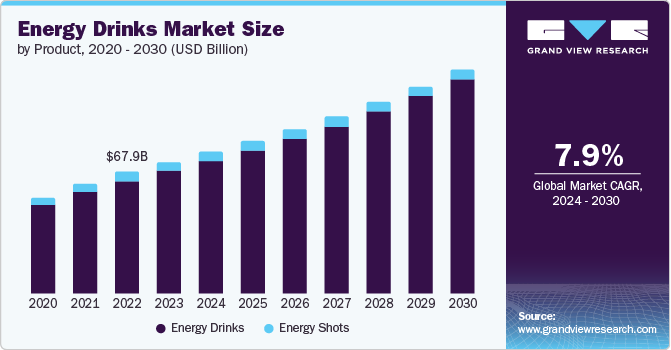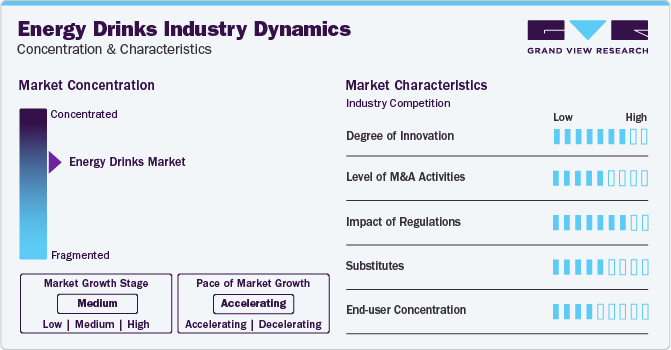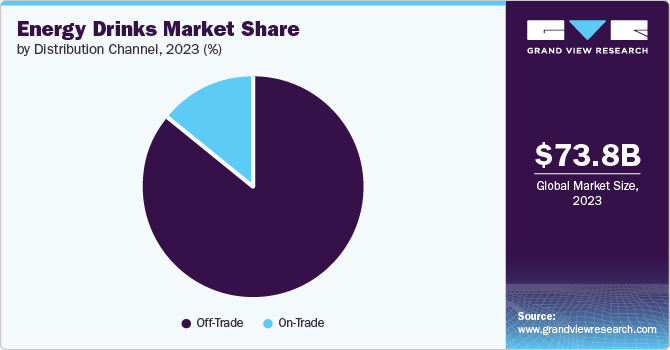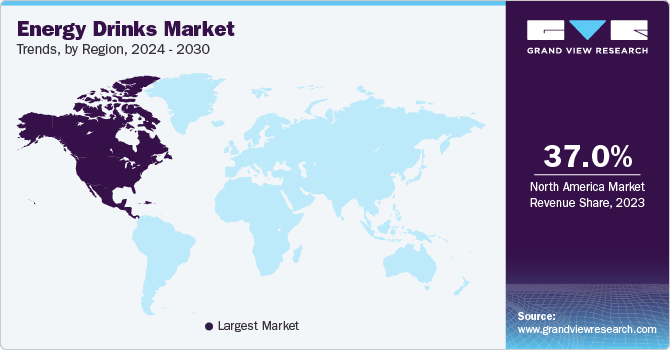
Energy Drinks Market Size, Share & Trend Analysis Report By Product (Energy Drinks, Energy Shots), By Type (Organic, Conventional), By Packaging, By Distribution Channel, By Region, And Segment Forecasts, 2024 - 2030
- Report ID: GVR-1-68038-951-7
- Number of Report Pages: 110
- Format: PDF, Horizon Databook
- Historical Range: 2018 - 2023
- Forecast Period: 2024 - 2030
- Industry: Consumer Goods
Energy Drinks Market Size & Trends
The global energy drinks market size was estimated at USD 73.81 billion in 2023 and is expected to grow at a CAGR of 7.9% from 2024 to 2030. Energy drinks have become increasingly popular among fitness enthusiasts and athletes due to their ability to provide a quick energy boost. These beverages are formulated with ingredients such as caffeine, taurine, B vitamins, and amino acids that enhance physical performance and mental alertness. They have also gained traction among gamers seeking quick and convenient ways to maintain alertness and performance levels during marathon sessions and professional tournaments.

According to Mayo Clinic News Network, in 2022, energy drinks were the second most popular dietary supplement among young adults and teens in the U.S. Market players are actively promoting these beverages as functional drinks that enhance energy levels, alertness, and physical performance.
Brands are introducing energy drinks that are free of sugar and calories, catering to the demand for healthier alternatives that can benefit athletes and individuals struggling with obesity. Sugar-free options also cater to those with lactose intolerance. Energy drinks, including carbonated beverages, ready-to-drink tea, beverage concentrates, soft drinks, fruit and vegetable juices, and ready-to-drink coffee, are among the most popular choices.
Shifting consumer preferences, evolving lifestyles, changing tastes, and ongoing product innovations have fueled the demand for these beverages. Growing awareness about maintaining health drives consumers to consume energy drinks to stay hydrated, maintain proper liquid intake, and foster good health, further boosting market growth. Energy drinks are recognized as one of the fastest-growing segments in the global beverage industry, maintaining growth even during the pandemic when consumption patterns shifted significantly.
According to a 2023 survey by Tractor Beverage Co., 61% of the respondents think that organic products are healthier. Free from synthetic pesticides and GMOs, organic energy drinks appeal to the health-conscious demographic, driving their demand. Moreover, the preference for natural and clean-label products is on the rise. Consumers are becoming more mindful of the ingredients used in their beverages, seeking options that are minimally processed and free from artificial additives. Organic energy drinks align with this trend, offering a cleaner and more natural alternative to conventional counterparts.
The gaming market is a significant driver for the market growth. Gamers often engage in prolonged gaming sessions for competitive play, streaming, or recreational purposes. The culture surrounding gaming generally involves long hours of gameplay, intense focus, and late-night sessions. Gamers frequently seek ways to enhance performance and stay alert during extended gaming sessions. According to a study conducted by Esports Health and Performance Institute in November 2023, energy drinks have become gamers' go-to beverage choice.
Market Concentration & Characteristics
The energy drinks industry has seen moderate to high levels of innovation, characterized by new formulations with natural ingredients, reduced sugar content, functional benefits like mental focus and hydration, and packaging innovations such as resealable caps and sustainable materials. These innovations aim to cater to evolving consumer preferences for healthier, more sustainable energy drink options.
Regulations in the energy drinks industry impact product formulation, marketing practices, and accessibility. They ensure safety standards for ingredients like caffeine and restrict advertising to minors, influencing market strategies and consumer perception of health and safety.

Substitutes like coffee, tea, and natural energy boosters impact the market by offering healthier alternatives with perceived benefits like antioxidants and lower sugar content. These alternatives appeal to health-conscious consumers seeking sustained energy without the potential drawbacks of excessive caffeine or artificial ingredients found in traditional energy drinks.
End user concentration in the energy drinks industry focuses heavily on young adults and professionals seeking increased alertness and stamina. These consumers prioritize convenience, flavor variety, and functional benefits such as energy boosts and mental focus.
Product Insights
Energy drinks accounted for a market share of 93 % in 2023. Energy drinks provide an immediate increase in energy and alertness due to ingredients such as caffeine, taurine, B vitamins, and various stimulants. These drinks are distinct from energy, largely due to their unique compositions and the benefits they offer, such as combating fatigue and enhancing performance. In April 2020, Taisho Pharmaceutical Holdings Co. Ltd in Japan launched the country's first caffeine-free energy drink featuring enXtra, a botanical ingredient clinically proven to enhance alertness and focus for up to five hours without caffeine. This innovation offers an alternative for consumers seeking caffeine-free options to boost mental and physical performance.
The energy shots segment is expected to grow at a CAGR of 1.1% from 2024 to 2030. The growth of the energy shots segment is driven by various factors, such as the increasing demand for convenience and portability. Energy shots offer a quick and easy solution for consumers looking to boost their energy levels on the go. They are typically smaller and come in portable packaging, making them an ideal choice for consumers with busy lifestyles. In April 2024, Living Essentials Marketing, LLC, the creators of 5-hour ENERGY, unveiled a new product range targeted at the gaming community. The lineup, named Gamer Shot, has three innovative flavors designed to enhance focus and energy for gamers. These Gamer Shots are formulated with B vitamins, taurine, and amino acids, aiming to provide sustained energy and concentration without causing jitteriness or energy crashes.
Type Insights
Conventional energy drinks accounted for a market share of 92% in 2023.The conventional segment of energy drinks is characterized by its reliance on artificial ingredients, such as synthetic caffeine, taurine, and various other additives. These energy drinks are typically formulated to provide a quick boost of energy through a combination of stimulants and sugars. The conventional segment often appeals to consumers looking for an immediate energy kick without the emphasis on natural or organic ingredients. This segment is known for its wide availability, aggressive marketing strategies, and often lower pricing compared to organic alternatives. For instance, the Raspberry Razz 5-hour ENERGY drink by Living Essentials Marketing, LLC contains caffeine, along with B vitamins and other nutrients.
Organic energy drinks are expected to grow at a CAGR of 10.3% from 2024 to 2030.The organic segment is primarily driven by consumer demand for healthier and natural beverage options. Consumers increasingly seek products free from artificial ingredients, chemicals, and pesticides. This shift toward organic energy drinks is fueled by a growing awareness of health and wellness, along with concerns about the potential negative effects of consuming conventional energy drinks with high levels of sugar and synthetic additives. For instance, in December 2023, Wholesome Organics Co., a health food company, introduced Clean Energy Shot. It is designed for individuals looking for an organic energy enhancement with additional health benefits.
Packaging Insights
Canned energy drinks accounted for a market share of 88% in 2023. Cans offer better preservation of the product’s taste and freshness compared to other packaging options such as cartons or pouches. Energy drinks contain various ingredients, such as vitamins, minerals, and caffeine, that can degrade over time when exposed to air or light. Cans provide an effective barrier against these external factors, ensuring that the product maintains its taste and quality for an extended period. For instance, as per Red Bull GmbH, aluminum cans are 20% more transport-efficient than plastic containers and 40% more than glass bottles.
Bottled energy drinks are expected to grow at a CAGR of 7.8% from 2024 to 2030. The convenience and portability of bottles make them a popular choice among consumers who lead active lifestyles or are frequently on the go. The resealable nature of bottles allows for easy consumption over multiple sittings, catering to those who prefer to consume their energy drinks gradually. Moreover, the larger surface area of bottles compared to cans provides ample space for branding and marketing efforts, making them visually appealing to consumers. For instance, in September 2022, UPTIME Energy unveiled a new bottle design at the NACS Show 2022, featuring a shorter height and wider base while retaining its resealability.
Distribution Channel Insights
The sales of energy drinks through the off-trade channel accounted for a market share of 86% in 2023. The off-trade segment refers to distribution channels where products are sold for consumption outside the premises where they are purchased. These include supermarkets, convenience stores, gas stations, and online retailers. In May 2023, WOX Energy Drinks India expanded its retail footprint through a partnership with G Town Wines, a distinguished chain known for offering a wide range of both Indian and imported liquor brands. This collaboration enabled WOX Energy Drinks to enhance product availability in multi-brand retail outlets, providing consumers with easier access to its full lineup, including the classic edition.

On-trade sales of energy drinks are expected to grow at a CAGR of 6.0% from 2024 to 2030. The on-trade segment in the energy drinks market includes bars, restaurants, clubs, and cafes where beverages are consumed immediately. Establishments in this channel can offer specialized or craft energy drinks, enhancing exclusivity and luxury for consumers. In May 2023, Ghost Beverages, LLC and Insomniac Holdings, LLC partnered to launch a limited-edition GHOST ENERGY drink at Electric Daisy Carnival (EDC) Las Vegas, featuring an EDC-themed can design. Ghost Beverages, LLC became the exclusive energy partner for all Insomniac events in the U.S., focusing on unique can designs, event activations, and integrated experiences across Insomniac festivals and events.
Regional Insights
The energy drinks market in North America accounted for a market share of around 37% in 2023 in the global market. In this region, the demand for energy drinks is primarily fueled by a fast-paced lifestyle and a strong emphasis on health and wellness. Consumers in this region increasingly seek functional beverages that offer energy-boosting properties and health benefits. This has led to a rise in the popularity of natural and organic energy drinks and products with added vitamins and minerals to cater to health-conscious consumers. For instance, Vive Organic offers energy + immunity shots made with ashwagandha, ginseng, turmeric root, ginger root, lion’s mane, and green tea.

U.S. Energy Drinks Market Trends
The energy drinks market in the U.S. accounted for a market share of around 85% in 2023 in the North American region. The industry here is dynamic and competitive, with the presence of well-known brands such as Red Bull, Monster Energy, and Rockstar. The presence of tech hubs such as Silicon Valley contributes to a culture where energy drinks are often consumed to enhance focus and productivity. In February 2024, Odyssey Wellness LLC, a functional beverage startup, secured USD 6 million in equity funding, raising the total investment to USD 14 million since its launch two years ago. The company produces energy drinks infused with 2,750 milligrams of Lion’s Mane and Cordyceps mushrooms to enhance cognitive clarity and focus.
Asia Pacific Energy Drinks Market Trends
The energy drinks market in Asia Pacific is anticipated to rise at a CAGR of about 9.6% from 2024 to 2030. Rapid urbanization across many countries in the Asia Pacific has resulted in extremely busy lifestyles, wherein individuals often seek quick energy boosts to keep up with their daily activities. According to a study published by the Journal of Nutrition and Metabolism in 2022, the primary reason for consuming energy drinks is to stay awake and alert. Energy drinks provide a convenient solution for people who need a quick pick-me-up during work hours, study sessions, or social gatherings. This demographic shift toward urban living has created a favorable environment for the growth of the market in Asia Pacific.
Key Energy Drinks Company Insights
The energy drinks industry is consolidated. Key players in the market are actively pursuing strategic initiatives such as product launches, reformulations, expansion, and acquisitions. These efforts aim to strengthen market presence, expand consumer reach, and enhance product offerings. For example, in February 2024, Suntory Holdings Limited expanded its Lucozade portfolio by launching three new products: Lucozade Sport Blue Force, Lucozade Energy Blue Burst, and Lucozade Alert Blue Rush. This move aimed to broaden the brand's range through a strategic marketing revision.
Key Energy Drinks Companies:
The following are the leading companies in the energy drinks market. These companies collectively hold the largest market share and dictate industry trends.
- Red Bull GmbH
- Taisho Pharmaceutical Holdings Co. Ltd.
- PepsiCo, Inc.
- Monster Beverage Corporation
- Suntory Holdings Limited
- The Coca-Cola Company
- Amway Corp
- AriZona Beverages USA
- Living Essentials Marketing, LLC
- Keurig Dr Pepper, Inc
Recent Developments
-
In April 2024, GURU Organic Energy Corp., Canada's organic energy drink brand, launched Peach Mango Punch in Canada, supported by a national marketing campaign. This new drink, low in calories and rich in natural ingredients, aims to enhance focus and brain performance. It contains caffeine and plant-based ingredients and is certified organic without sucralose or aspartame. Key ingredients include L-theanine, monk fruit, and stevia, contributing to its health benefits and sweetness.
-
In February 2024, Red Bull GmbH launched its Summer Edition Curuba Elderflower drink in a 250ml can. This flavor, featuring a mix of curuba and elderflower, was made in multiple formats, including sugar-free options. The brand expanded its customer base by 50% with its 'Editions' range and introduced an 8x250ml mixed sugar-free multipack to meet growing demand.
-
In January 2024, Celsius Holdings, Inc. expanded its products into Canada, the UK, and Ireland through PepsiCo, Inc. and Suntory Beverage & Food Great Britain and Ireland. PepsiCo is the exclusive distributor in Canada, extending an agreement from the U.S. in 2022. Suntory Beverage & Food Limited was selected for exclusive sales and distribution in the UK, the Isle of Man, the Channel Islands, and the Republic of Ireland.
Energy Drinks Market Report Scope
|
Report Attribute |
Details |
|
Market size value in 2024 |
USD 79.39 billion |
|
Revenue forecast in 2030 |
USD 125.11 billion |
|
Growth Rate (Revenue) |
CAGR of 7.9% from 2024 to 2030 |
|
Actuals |
2018 - 2023 |
|
Forecast period |
2024 - 2030 |
|
Report updated |
July 2023 |
|
Quantitative units |
Revenue in USD million/billion and CAGR from 2024 to 2030 |
|
Report coverage |
Revenue forecast, company ranking, competitive landscape, growth factors, and trends |
|
Segments covered |
Product, type, packaging, distribution channel, and region. |
|
Regional scope |
North America, Europe, Asia Pacific, Central & South America, & Middle East & Africa |
|
Country scope |
U.S, Canada, Mexico, UK, Germany, China, Japan, India, Thailand, Brazil |
|
Key companies profiled |
Red Bull GmbH; Taisho Pharmaceutical Holdings Co. Ltd.; PepsiCo, Inc.; Monster Beverage Corporation; Suntory Holdings Limited; The Coca-Cola Company; Amway Corp; AriZona Beverages USA; Living Essentials Marketing, LLC; Keurig Dr Pepper, Inc. |
|
Customization |
Free report customization (equivalent up to 8 analysts working days) with purchase. Addition or alteration to country, regional & segment scope. |
|
Pricing and purchase options |
Avail customized purchase options to meet your exact research needs. Explore purchase options |
Global Energy Drinks Market Report Segmentation
This report forecasts revenue growth at the regional and country levels and analyzes the latest industry trends and opportunities in each of the sub-segments from 2018 to 2030. For this study, Grand View Research has segmented the global energy drinks market report based on product, type, packaging, distribution channel, and region.
-
Product Outlook (Revenue, USD Billion, 2018 - 2030)
-
Energy Drinks
-
Energy Shots
-
-
Type Outlook (Revenue, USD Billion, 2018 - 2030)
-
Organic
-
Conventional
-
-
Packaging Outlook (Revenue, USD Billion, 2018 - 2030)
-
Bottles
-
Cans
-
Others
-
-
Distribution Channel Outlook (Revenue, USD Billion, 2018 - 2030)
-
On-Trade
-
Off-Trade
-
-
Regional Outlook (Revenue, USD Billion, 2018 - 2030)
-
North America
-
U.S.
-
Canada
-
Mexico
-
-
Europe
-
UK
-
Germany
-
-
Asia Pacific
-
China
-
Japan
-
India
-
Thailand
-
-
Central & South America
-
Brazil
-
-
Middle East & Africa
-
Frequently Asked Questions About This Report
b. The growing demand for energy drinks as a potential energy booster in order to improve physical and cognitive performance has been shaping the market growth. Market players are aggressively marketing energy drinks as functional beverages that uplift energy and alertness as well as provide a physical boost.
b. The global energy drinks market was estimated at USD 73.81 billion in 2023 and is expected to reach USD 79.39 billion in 2024.
b. The global energy drinks market is expected to grow at a compound annual growth rate of 7.9% from 2024 to 2030 to reach USD 125.11 million by 2030.
b. North America dominated the energy drinks market with a share of around 37% in 2023. This is due to its high consumer demand driven by active lifestyles and a strong sports culture.
b. Some key players operating in the energy drinks market include Red Bull, Taisho Pharmaceutical Co Ltd., PepsiCo. Inc, Monster Energy, Lucozade, The Coco-Cola Company, Amway, AriZona Beverages USA, Living Essentials LLC, and Xyience Energy
We are committed towards customer satisfaction, and quality service.
"The quality of research they have done for us has been excellent."




